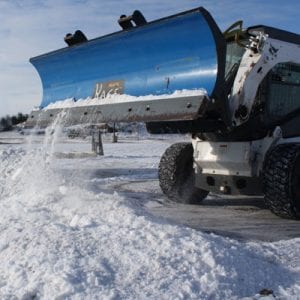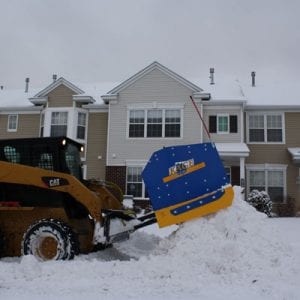 Attention Skid Steer Snow Plow Operators
Attention Skid Steer Snow Plow Operators
We’re a company that builds its products through experience and one thing you can count on in the snow removal industry is accidents. Hazards lie everywhere when snow falls, but as professional skid steer Snow Plow Operators are concerned, many of those hazards can be avoided with proper training and preparation.
While there are countless ways an operator can quickly get into trouble plowing snow with a skid steer, we chose to highlight the top 3 Snow Plowing Tips to Avoid Job Site Accidents.
Tip #1: Don’t Bury Valuable Objects That Can Become Future Hazards
Some these objects shouldn’t need to be mentioned, but again, experience has told us that it should. When you’re pushing snow to an area of the lot where it’s away from frequented parking stalls or pedestrian traffic you should also be aware of things beyond the curb – things like fire hydrants, young newly planted trees or shrubs, phone boxes, electrical outlet stations, ground-level lighting, trash bins, bike racks and more. You get what we’re saying.
For one, these items need to be accessed throughout the winter and shouldn’t be buried. Secondly, if you bury it, you have a high probability of hitting it when you’re hogging snow to pile later and forget it’s buried down under there.
Interesting Story: Two Kids Buried By Snow Plow Operator While Making a Snow Fort In a Parking Lot Snow Pile:
Tip #2: Try to Always Be Moving Forward for Maximum Visibility
 This is a big reason why we like our skid steers for plowing snow – we can plow in either direction reducing the need to back up. So why don’t we do it more. From time to time, we still observe skid steer snow plow operators driving like they’re still in a truck.
This is a big reason why we like our skid steers for plowing snow – we can plow in either direction reducing the need to back up. So why don’t we do it more. From time to time, we still observe skid steer snow plow operators driving like they’re still in a truck.
Any time you’re able to spin that machine around and plow forward, do it. Some skid steers have awesome peripheral visibility, but imagine you’re out plowing for 8 to 12 hours straight. Your mind begins to wander and turning that skid steer around to plow in the other direction doesn’t seem like such a top priority. You plow past a light pole pushing the snow to the pile and back up forgetting how close that light really was. BAM! Next you’re on the phone calling your boss about damaged property.
You have that option to spin around on the spot, so use it. If anything, you’re changing up the view which keeps your mind in a more aware state.
Tip #3: Be Aware of Pedestrians & Other Moving Vehicles
 Our last tip is without a doubt the most important one. If you’re a seasoned snow removal guy or girl, you know that the general public does NOT look out for us … it’s actually the other way around. In this day & age of cell phones and texting, many pedestrians and vehicle drivers have their heads buried into a text message or whatever. Really, it’s our duty to watch out for them regardless of who we feel has the right of way in any instance. It’s better to always err on the side of caution and courtesy to let them continue on their way.
Our last tip is without a doubt the most important one. If you’re a seasoned snow removal guy or girl, you know that the general public does NOT look out for us … it’s actually the other way around. In this day & age of cell phones and texting, many pedestrians and vehicle drivers have their heads buried into a text message or whatever. Really, it’s our duty to watch out for them regardless of who we feel has the right of way in any instance. It’s better to always err on the side of caution and courtesy to let them continue on their way.
Plowing snow with a skid steer is great because it’s faster than using a truck and it’s more nimble in tighter spots, but because it moves faster than a truck plow and it can swing around quick to go forward in either direction, the operator has to be extra aware of their surroundings.
In the End, It’s All About the Mental & Physical Preparation
These 3 snow plowing tips are just the top of the snow pile. There’s so many hazards just waiting in the white stuff that could potentially put your operator and business in a bind. Get your crew mentally and physically prepped for those bigger snow storms. Make sure they’re getting plenty of rest and know the job sites forward, backward and sideways. Then and only then will accidents be more avoidable.
Everyone at KAGE wishes your team nothing but success this winter season. Be safe out there!

Recent Comments